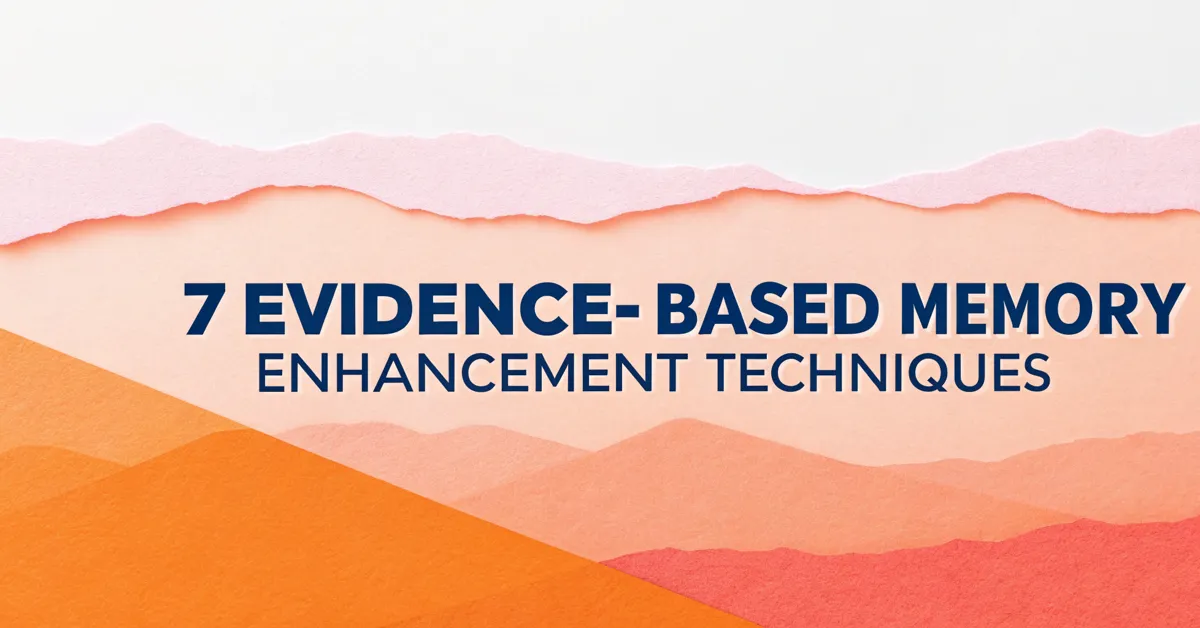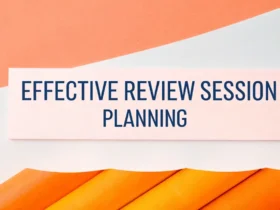Staring at the blank page can be daunting. Exams loom, and the pressure to remember everything feels immense. You’re not alone. Many students struggle with memory, especially when faced with mountains of information. But what if you could train your brain, not just to cram, but to truly retain knowledge?
Forget magic pills and outlandish claims. This isn’t about tricks, it’s about science. Solid research backs proven methods that can sharpen your memory and improve your recall. This article unveils seven evidence-based techniques to help you unlock your memory’s full potential. These techniques aren’t just quick fixes; they’re strategies for long-term memory improvement. They’re about working with your brain, not against it, to learn more effectively and remember more efficiently.
Understanding How Memory Works
Before diving into the techniques, it helps to understand how memory functions. Think of your brain as a library. Sensory information arrives constantly. Most of it gets discarded immediately. But if you pay attention to something, it moves to short-term memory, the librarian’s desk. Short-term memory is fleeting. It can hold only a small amount of data for a brief period. To make information stick, you need to move it to the long-term storage, the library’s shelves. This process involves several stages:
- Encoding: Transforming information into a format your brain can store.
- Storage: Maintaining the encoded information over time.
- Retrieval: Accessing the stored information when needed.
Memory improvement relies on optimizing each of these stages. The following techniques target these processes, helping you to encode information more effectively, store it securely, and retrieve it reliably.
7 Evidence-Based Memory Enhancement Techniques
These techniques are not overnight miracles. They require consistent effort and practice. But with dedication, you can significantly enhance your memory and academic performance.
1. Active Recall: Test Yourself, Don’t Just Reread
Rereading notes is a common study habit, but it’s often a passive process. You might feel like you’re learning, but are you truly absorbing the information? Active recall turns learning into a workout for your brain. It involves actively retrieving information from memory, rather than passively reviewing it.
Imagine you’re learning about the French Revolution. Instead of simply rereading your textbook chapter, try this:
- Close your book.
- On a blank piece of paper, write down everything you can remember about the causes of the French Revolution. Don’t worry about being perfect. Just try to recall as much as possible.
- Once you’ve exhausted your memory, check your textbook or notes. Identify any gaps in your knowledge and fill them in.
- Repeat this process regularly, spacing out your practice sessions over time.
Why it works: Active recall strengthens the neural pathways associated with the information you’re trying to learn. Each time you successfully retrieve information, you reinforce those pathways, making it easier to recall in the future. Rereading, on the other hand, can create a false sense of familiarity. You recognize the information, but you haven’t actually tested your ability to retrieve it independently. Studies show active recall is significantly more effective than passive rereading for long-term retention.
How to implement:
- Use flashcards: Create flashcards with questions on one side and answers on the other. Quiz yourself regularly, focusing on the cards you find most challenging.
- Practice questions: Work through practice questions and past papers. This forces you to apply your knowledge and retrieve information under exam-like conditions.
- Teach someone else: Explaining concepts to someone else is a great way to test your understanding and identify any gaps in your knowledge.
2. Spaced Repetition: The Power of Timed Reviews
Cramming might help you pass an exam, but it’s a terrible strategy for long-term retention. Information crammed into your brain tends to disappear quickly. Spaced repetition involves reviewing information at increasing intervals over time. This technique leverages the “forgetting curve,” the natural decline in memory retention that occurs over time.
Imagine learning a new vocabulary word in Spanish: “biblioteca” (library).
- Review the word shortly after learning it (e.g., within an hour).
- Review it again the next day.
- Review it again three days later.
- Review it again a week later.
- Review it again a month later.
As you become more confident in your ability to recall the word, you can increase the intervals between reviews.
Why it works: Spaced repetition exploits the psychological spacing effect, which indicates that learning is more effective when study sessions are spaced out, rather than massed together. By reviewing information just as you’re about to forget it, you force your brain to work harder to retrieve it. This strengthens the memory trace and makes it more resistant to decay.
How to implement:
- Use spaced repetition software (SRS): Apps like Anki and Memrise automate the spaced repetition process. They track your progress and schedule reviews based on your performance.
- Create a review schedule: If you prefer a more manual approach, create a schedule for reviewing your notes and flashcards. Gradually increase the intervals between reviews.
- Integrate with active recall: Combine spaced repetition with active recall by testing yourself on the material at each review session.
3. Elaborative Interrogation: Ask “Why” to Deepen Understanding
Simply memorizing facts is often insufficient for true understanding. Elaborative interrogation involves asking “why” questions to connect new information to your existing knowledge. This technique forces you to think critically about the material and make meaningful connections.
Imagine you’re learning about the causes of World War I. Instead of simply memorizing a list of factors, ask yourself:
- Why did nationalism contribute to the outbreak of war? How did it create tensions between different countries?
- Why was the alliance system so dangerous? How did it turn a local conflict into a global war?
- Why did imperialism lead to increased competition between European powers? How did it fuel resentment and mistrust?
By answering these “why” questions, you’re not just memorizing facts; you’re building a deeper understanding of the underlying causes of the war.
Why it works: Elaborative interrogation promotes deeper processing of information. It forces you to make connections between new material and your existing knowledge, creating a richer and more meaningful memory trace. This makes the information more memorable and easier to retrieve.
How to implement:
- Ask “why” questions: Whenever you encounter a new fact or concept, ask yourself “why?” Why is this true? Why is this important? Why does this matter?
- Connect to prior knowledge: Relate the new information to what you already know. How does it fit in with your existing understanding of the world?
- Generate explanations: Try to explain the material in your own words. This forces you to think critically about the information and identify any gaps in your understanding.
4. Dual Coding: Combine Words with Visuals
Our brains are wired to process visual information more efficiently than text. Dual coding theory suggests that we can improve memory by combining verbal and visual information. This creates two separate but interconnected memory traces, providing more retrieval cues.
Imagine you’re learning about the different parts of a cell. Instead of just reading about the nucleus, mitochondria, and ribosomes, try this:
- Draw a diagram of a cell.
- Label each part of the cell.
- Write a brief description of the function of each part.
By combining the verbal descriptions with a visual diagram, you’re creating two separate memory traces that reinforce each other.
Why it works: Dual coding provides multiple pathways for retrieving information. If you forget the verbal description of a cell part, you might still be able to recall its visual representation. The combination of verbal and visual information creates a richer and more durable memory trace.
How to implement:
- Use diagrams and illustrations: Include diagrams, charts, graphs, and other visual aids in your notes and study materials.
- Create mind maps: Use mind maps to visually organize information and show the relationships between different concepts.
- Watch videos: Supplement your reading with videos that explain the material in a visual way.
5. Mnemonic Devices: Create Memory Aids
Mnemonic devices are memory aids that help you encode and retrieve information. They can take many forms, including acronyms, rhymes, and visual imagery.
Imagine you need to remember the order of the planets in our solar system: Mercury, Venus, Earth, Mars, Jupiter, Saturn, Uranus, Neptune. Use the mnemonic phrase:
“My Very Educated Mother Just Served Us Noodles.”
Each word’s first letter corresponds to a planet’s first letter, making it easier to remember the order.
Why it works: Mnemonic devices transform abstract information into something more concrete and memorable. They create a strong retrieval cue that helps you access the information when needed.
How to implement:
- Create acronyms: Use acronyms to remember lists of items. For example, “ROY G. BIV” helps you remember the colors of the rainbow (Red, Orange, Yellow, Green, Blue, Indigo, Violet).
- Use rhymes: Rhymes are easy to remember and can be used to encode information. For example, “In 1492, Columbus sailed the ocean blue.”
- Create visual imagery: Associate each item you want to remember with a vivid and memorable image.
6. The Method of Loci: “Memory Palace” for Spatial Recall
The Method of Loci, also known as the “memory palace,” is a powerful mnemonic technique that involves associating information with specific locations in a familiar place.
Imagine you need to remember a list of historical figures: Julius Caesar, Cleopatra, Napoleon Bonaparte, Queen Elizabeth I, Abraham Lincoln.
- Visualize a familiar place, such as your house or apartment.
- Choose a series of distinct locations within that place, such as the front door, the living room, the kitchen, the bedroom, and the bathroom.
- Associate each historical figure with one of these locations. For example, imagine Julius Caesar standing at your front door, Cleopatra lounging in your living room, Napoleon cooking in your kitchen, Queen Elizabeth I sleeping in your bedroom, and Abraham Lincoln taking a bath.
- When you need to recall the list of historical figures, simply mentally walk through your memory palace and retrieve the images you associated with each location.
Why it works: The Method of Loci leverages our brains’ natural ability to remember spatial information. By associating information with specific locations, you’re creating a strong and durable memory trace.
How to implement:
- Choose a familiar place: Select a place that you know well and can easily visualize.
- Identify distinct locations: Choose a series of distinct locations within that place.
- Create vivid images: Associate each item you want to remember with a vivid and memorable image at each location.
- Practice regularly: Mentally walk through your memory palace regularly to reinforce the associations.
7. Get Enough Sleep and Exercise: Prioritize Brain Health
While the previous techniques focus on specific strategies for improving memory, it’s important to remember the importance of overall brain health. Sleep and exercise are crucial for optimal cognitive function, including memory.
Sleep: During sleep, your brain consolidates memories, transferring information from short-term to long-term storage. Lack of sleep can impair memory consolidation and make it difficult to learn new information.
Exercise: Exercise increases blood flow to the brain, which can improve cognitive function and protect against age-related memory decline. Exercise also promotes the release of brain-derived neurotrophic factor (BDNF), a protein that supports the growth and survival of neurons.
Why it works: Sleep and exercise create a foundation for optimal cognitive function. Without adequate sleep and exercise, it’s difficult for any memory technique to be truly effective.
How to implement:
- Aim for 7-8 hours of sleep per night: Establish a regular sleep schedule and create a relaxing bedtime routine.
- Get regular exercise: Aim for at least 30 minutes of moderate-intensity exercise most days of the week.
- Prioritize brain health: Make lifestyle choices that support brain health, such as eating a healthy diet, managing stress, and avoiding smoking and excessive alcohol consumption.
Making These Techniques a Habit
You now know the secrets to memory improvement. But information is nothing without action. The key to success lies in integrating these techniques into your daily study routine. Start small. Pick one or two techniques that resonate with you and experiment with them. Be patient. It takes time and effort to train your brain. Track your progress and celebrate your successes. As you become more proficient, you can gradually incorporate more techniques into your repertoire.
Beyond Exams: Memory for Life
These techniques aren’t just for exams. They’re skills that can benefit you throughout your life. They can help you learn new things more easily, remember important details, and stay mentally sharp as you age.
Memory improvement is a journey, not a destination. Embrace the challenge and enjoy the process of unlocking your brain’s full potential.
Unlocking Your Memory: Is It Worth the Effort?
Putting in the effort to improve your memory can feel daunting. However, the ability to recall information efficiently transforms learning from a chore into an empowering experience. Implementing these seven evidence-based techniques not only helps you ace your exams but also equips you with lifelong learning skills. The rewards, in terms of academic success and cognitive well-being, make the commitment worthwhile. So, take the leap, experiment with these strategies, and unlock the remarkable potential of your memory.















Leave a Reply
View Comments